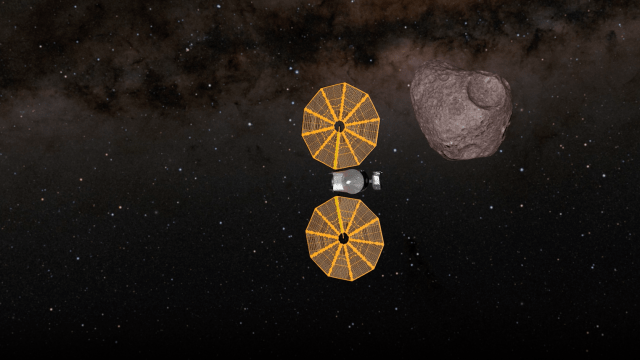After travelling millions of miles over the past two years, the Lucy spacecraft has almost reached its first destination. NASA’s asteroid probe will briefly rendezvous with Dinkinesh in the main asteroid belt on Wednesday to prepare for its future visits of Jupiter’s Trojan asteroids.
The spacecraft will make its closest approach to the asteroid at a distance of approximately 265 miles (425 kilometres) at 12:54 p.m. E.T on November 1, according to NASA. “This is the first time Lucy will be getting a close look at an object that, up to this point, has only been an unresolved smudge in the best telescopes,” Hal Levison, Lucy principal investigator from the Southwest Research Institute, said in a statement. “Dinkinesh is about to be revealed to humanity for the first time.”
Lucy has been visually tracking Dinkinesh since September 3. On Saturday, the team behind the mission sent Lucy its final knowledge update, a package of data that includes the most up to date information about the relative positions of the spacecraft and asteroid. The data package will guide the spacecraft for the rest of the distance that separates it from the asteroid, which is currently at about half a million miles (800,000 kilometres).
The spacecraft will begin actively monitoring the position of Dinkinesh with its terminal tracking system about an hour before its closest approach, at which point Lucy will be around 10,000 miles (16,000 km) away from the asteroid. Dinkinesh is a small little guy, measuring at around half a mile wide (1 km). As a result, the system will not fully lock-on to the asteroid until just a few minutes before the spacecraft’s closest approach.
The flyby will test the spacecraft’s terminal tracking system for the first time, which is designed to autonomously pinpoint the location of the asteroid and keep it within the instruments’ field-of-view. During the last eight minutes of the flyby, Lucy will collect data on the asteroid using its colour imager and infrared spectrometer that comprise the L’Ralph instrument, according to NASA.
“We’ll know what the spacecraft should be doing at all times, but Lucy is so far away it takes about 30 minutes for radio signals to travel between the spacecraft and Earth, so we can’t command an asteroid encounter interactively,” Mark Effertz, Lucy chief engineer at Lockheed Martin Space, said in a statement. “Instead, we pre-program all the science observations.”
After Wednesday’s flyby, Lucy will continue to image and track Dinkinesh for about another hour. The spacecraft will then reorient itself to resume communications with Earth, while still imaging the asteroid with its high-resolution camera, L’LORRI, for the next four days.
The Lucy mission launched in October 2021 with the aim of studying the Trojan asteroids, a group of rocky bodies that lead and follow Jupiter as it orbits the Sun. Lucy will begin its tour of the Trojan asteroids in 2027 by visiting Eurybates and its binary partner Queta, followed by Polymele and its binary partner, Leucus, Orus, and the binary pair Patroclus and Menoetius.
Earlier this year, Dinkinesh was added to Lucy’s list of asteroid targets as a way to test the spacecraft’s instruments before it reaches the Jovian system. Dinkinesh, or ድንቅነሽ in Amharic, the Ethiopian name for the human-ancestor fossil that’s also known as Lucy, was discovered in 1999 but was left unnamed until it was selected as a target for the mission in January.
